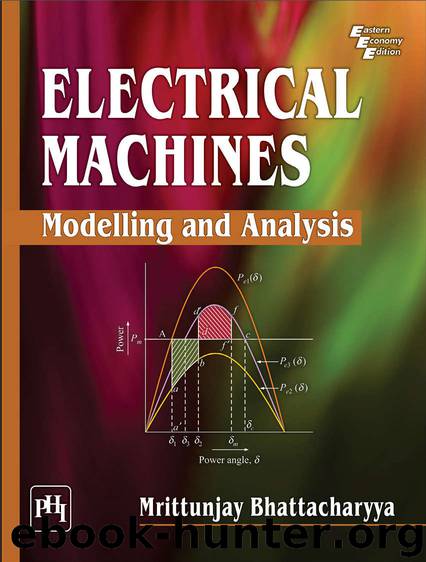Electrical Machines : Modelling and Analysis by Mrittunjay Bhattacharyya

Author:Mrittunjay Bhattacharyya [Bhattacharyya, Mrittunjay]
Language: eng
Format: azw3
Publisher: PHI Learning
Published: 2018-09-09T16:00:00+00:00
7
Analysis of Actual Machine Configurations
7.1 Conventions Adopted for General Analysis
Before commencing the study of motor and generator action of actual configurations, it becomes absolutely necessary to elaborate the conventions adopted in this book about the flow of current and the resulting electro-magnetic torque. It is also important for us to indicate clearly the basis on which these assumptions are adopted. A coil is invariably represented by a cluster of conductors with a specified axis of its influence along the axis of its symmetry. When current flows through such a coil, an mmf is developed along this axis and flux is produced.
A positive mmf/flux is produced when it is along the radial direction and is pointed radially outwards away from the centre of the representative diagram. This means that the direction of turning of the coil is in the counter-clockwise sense when viewed from the top and the pole formation at the point of entry of the current (at the end nearer to the centre of the diagram) is South Pole. The positive direction of the current flow in the coil is therefore at the end of the coil nearer to the centre of the diagram, which is taken as positive. To this end, the instantaneous positive voltage is taken as applied and this terminal is taken to be at a higher potential. Since the applied voltage is taken as positive and causes a positive current flow into a coil, an electric power flow into the electrical circuit is taken as positive, that is, motoring action is assumed as positive in our convention.
The phase layout of an ac winding having a-b-c phase sequence, presents the axis of symmetry of the phase a followed by axis of symmetry of b-phase, a electrical behind in the clockwise direction, followed by c-phase, a electrical behind the phase a axis. The rotating magnetic field produced in such a winding fed by a 3-phase ac supply with a-b-c phase sequence revolves from a → b → c along the clockwise direction. We assume the clockwise direction of rotation to be the positive direction of rotation. However, we should always keep in the back of our minds that the positive angle is measured along the counter-clockwise direction.
In a primitive machine representation, the reference currents are always shown to be positive, that is, there are shown as entering the coils at the positive potential ends. As has already been pointed out, the end of the coils where the reference currents enter are considered as developing south poles. If then, for a particular case, the current is found from the analysis as leaving the positive terminal, the coil current denoted by a different symbol is taken as negative. The two positive alternative cases are indicated in the reference diagram in Figure 7.1.
Download
This site does not store any files on its server. We only index and link to content provided by other sites. Please contact the content providers to delete copyright contents if any and email us, we'll remove relevant links or contents immediately.
| Automotive | Engineering |
| Transportation |
Whiskies Galore by Ian Buxton(41525)
Introduction to Aircraft Design (Cambridge Aerospace Series) by John P. Fielding(32885)
Small Unmanned Fixed-wing Aircraft Design by Andrew J. Keane Andras Sobester James P. Scanlan & András Sóbester & James P. Scanlan(32570)
Craft Beer for the Homebrewer by Michael Agnew(17930)
Turbulence by E. J. Noyes(7696)
The Complete Stick Figure Physics Tutorials by Allen Sarah(7135)
Kaplan MCAT General Chemistry Review by Kaplan(6591)
The Thirst by Nesbo Jo(6432)
Bad Blood by John Carreyrou(6271)
Modelling of Convective Heat and Mass Transfer in Rotating Flows by Igor V. Shevchuk(6219)
Learning SQL by Alan Beaulieu(6031)
Weapons of Math Destruction by Cathy O'Neil(5825)
Man-made Catastrophes and Risk Information Concealment by Dmitry Chernov & Didier Sornette(5644)
Digital Minimalism by Cal Newport;(5388)
Life 3.0: Being Human in the Age of Artificial Intelligence by Tegmark Max(5182)
iGen by Jean M. Twenge(5158)
Secrets of Antigravity Propulsion: Tesla, UFOs, and Classified Aerospace Technology by Ph.D. Paul A. Laviolette(4984)
Design of Trajectory Optimization Approach for Space Maneuver Vehicle Skip Entry Problems by Runqi Chai & Al Savvaris & Antonios Tsourdos & Senchun Chai(4837)
Electronic Devices & Circuits by Jacob Millman & Christos C. Halkias(4743)
